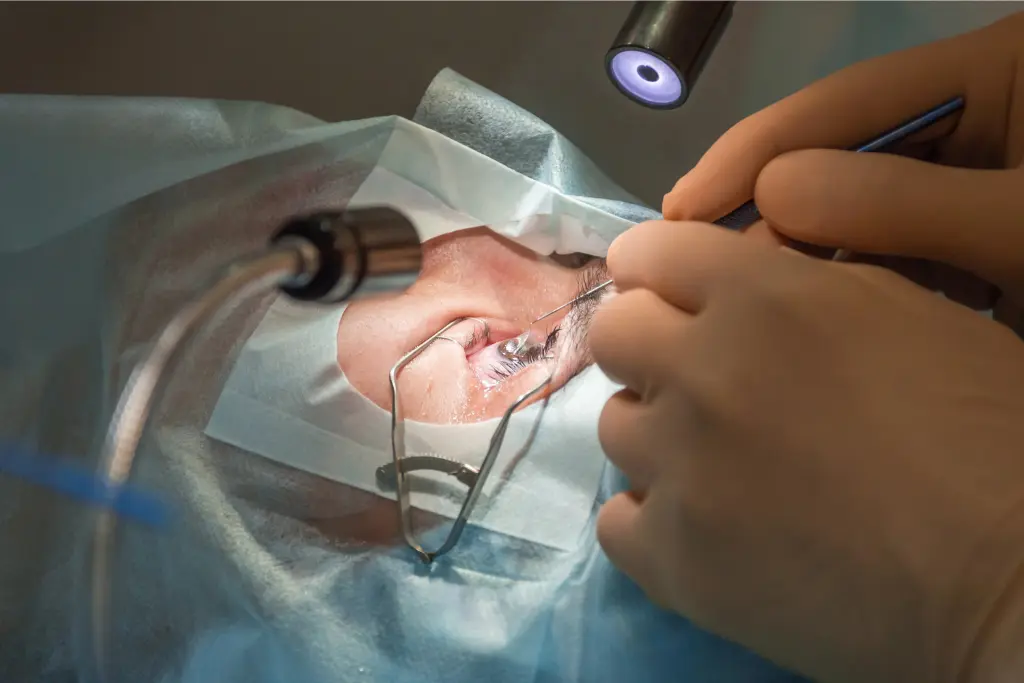It’s no wonder that LASIK has become one of the most popular choices for vision correction in Los Angeles. The freedom to see the Hollywood sign, the Pacific coastline, and the details of your daily life without the hassle of glasses or contacts is an irresistible promise.
LASIK is an elective surgery, and while technology has made it safer and more effective than ever before, the single most critical factor determining your safety and the success of your outcome is the surgeon you choose. Their skill, their experience, and their commitment to you as an individual patient will define your vision for years to come.
To help you navigate the process of selecting a provider, we’ve put together this clear, comprehensive checklist. Use it during your research and consultation phase to ensure you’re making the best, most informed decision for your eyesight.
Verify Board Certification and Credentials
The foundation of a good surgeon is their training and legal authorization to practice. Never take a surgeon’s word for their qualifications; verify them.
Look for Certification from the American Board of Ophthalmology (ABO): The ABO is the body that certifies ophthalmologists (eye physicians and surgeons) in the United States. Certification means the doctor has completed approved medical training and passed rigorous written and oral examinations. You can verify a physician’s certification status directly on the ABO’s website.
Confirm an Active State Medical License in California: A board certification proves expertise, but an active state license proves they are legally permitted to practice in Los Angeles. You can check the status of a physician’s license on the Medical Board of California’s website. This step will also alert you to any past or current disciplinary actions.
Years of Experience Specifically with LASIK Surgery: While a general ophthalmology background is important, look for a surgeon who has dedicated a significant part of their career to refractive surgery (procedures like LASIK, PRK, etc.). General experience is great; specialized LASIK experience is vital.
Assess Experience and Track Record
The total number of procedures performed is an excellent barometer of a surgeon’s proficiency. You want a veteran in the field.
Importance of the Number of LASIK Procedures Performed: Ask for a ballpark figure of the number of LASIK and other laser vision correction procedures the surgeon has personally performed. A surgeon who has performed thousands of procedures is generally better equipped to handle both routine cases and unexpected challenges than one with only hundreds.
Ask About Complication Rates and Success Outcomes: A candid surgeon will be transparent. While no surgeon has a 0% complication rate, ask what their rates are for specific issues, and what percentage of their patients achieve 20/20 vision or better. Be wary of anyone who claims a “100% success rate” without defining what that success means.
Experience with Different LASIK Technologies and Patient Cases: The best surgeons aren’t tied to one machine or one procedure type. Their experience should span a diverse range of patient prescriptions, corneal shapes, and vision correction technologies, demonstrating an ability to choose the right procedure for the right patient.
Check Technology and Equipment Used
Modern LASIK is highly dependent on technology. The tools a surgeon uses directly impact the procedure’s precision, safety, and predictability.
Availability of Advanced Tools: You want a surgeon who utilizes all-laser LASIK. This involves two key pieces of advanced equipment:
Femtosecond Laser: Used to create the corneal flap (replacing the older microkeratome blade, resulting in a safer, more precise flap).
Wavefront-Guided LASIK (or Topography-Guided LASIK): These systems create a unique, highly detailed 3D map of your eye’s imperfections, like a “fingerprint of your vision,” allowing the excimer laser to customize the treatment far beyond a standard contact lens or glasses prescription.
Why Modern Equipment Improves Precision and Safety: These advanced systems improve patient outcomes, often reducing the likelihood of post-operative side effects like glare, halos, and poor night vision.
Ask if Technology is FDA-Approved and Well-Maintained: Ensure the equipment is not only modern but is also certified by the U.S. Food and Drug Administration (FDA) for the specific procedure being performed. Furthermore, ask about the maintenance and calibration schedule for the lasers; this speaks volumes about the clinic’s commitment to safety standards.
Review Patient Reviews and Testimonials
Online reviews offer valuable insight into the patient experience, but they should be viewed critically.
Where to Find Trustworthy Reviews: Look beyond the clinic’s own website. Search for reviews on independent, third-party sites like Google Business Profile, Healthgrades, and RealSelf. These platforms often feature verified patient experiences.
Red Flags to Watch for in Patterns of Negative Feedback: Be attentive to recurring patterns in complaints, not just isolated negative reviews. Red flags include recurring mentions of poor bedside manners, a feeling of being rushed, unexpected or hidden fees, or long-term vision problems that were dismissed.
Balanced View: Remember, no surgeon has a perfect record. Pay attention to how the surgeon or clinic responds to negative feedback; a professional, non-defensive response that attempts to resolve the issue is a positive sign of accountability.
Evaluate Communication and Comfort Level
LASIK is a personal journey. Your relationship with your surgeon and their team should be one of comfort and trust.
Surgeons Should Explain Risks, Benefits, and Alternatives Clearly: A great surgeon will not simply “sell” you on LASIK. They will ensure you understand the specific risks for your eyes, the realistic benefits, and all available alternatives (like PRK or ICLs) that might be a better fit.
Importance of Realistic Discussions About Results: Look for honesty. A surgeon should never guarantee 20/20 vision, as everyone heals differently. They should set realistic expectations based on your current prescription and corneal health.
Feeling Comfortable Asking Questions and Expressing Concerns: The consultation is your opportunity to interview the surgeon. If you feel rushed, intimidated, or unable to fully express your concerns, that’s a clear sign to look elsewhere.
Consider Personalized Evaluation Process
LASIK should never be a one-size-fits-all procedure. The thoroughness of the pre-operative screening is an indicator of the surgeon’s integrity.
Comprehensive Pre-Op Exam Should Include: Your pre-op exam must go beyond a simple eye chart test. It should include detailed diagnostics like corneal mapping (topography/tomography), measurement of your pupil size (especially important for night vision), and a tear film assessment to check for dry eye syndrome.
No “One-Size-Fits-All” Approach: A reputable practice uses the diagnostic data to customize your treatment plan. If you feel your unique data is not being used to tailor the laser profile, ask why.
Surgeons Who Turn Away Ineligible Patients Show Integrity: The highest marker of a conscientious surgeon is their willingness to say “no.” If they determine that your corneas are too thin, your prescription is too high, or you have an underlying condition, a good surgeon will refuse to operate. This is integrity, and it should instill confidence.
Compare Costs and Payment Options
While cost should not be the only factor, it’s a necessary part of your decision-making.
Typical LASIK Pricing in Los Angeles and Factors That Affect It: The price of LASIK in Los Angeles typically falls in a wide range, often averaging between $1,500 and $3,500 per eye, depending on the technology used (e.g., custom wavefront is often more expensive than standard), the surgeon’s experience, and the degree of correction needed.
Beware of Discount Ads or Hidden Fees: Be extremely cautious of ads promoting prices that seem too good to be true, such as “$499 per eye.” These are almost always for very limited, low-prescription cases and lead to hidden, unexpected “upgrade” fees once you’re in the door. The price quoted to you should be all-inclusive.
Availability of Financing or Flexible Payment Plans: Many reputable Los Angeles centers offer third-party financing options (like CareCredit) or in-house payment plans, making the procedure more affordable by breaking the cost into manageable monthly payments.
Ask About Post-Operative Care and Follow-Up
The surgery is only one part of the journey; a successful result depends heavily on meticulous aftercare.
Frequency of Follow-Up Visits After Surgery: Ensure the clinic provides a clear schedule for your post-op visits (typically the day after, one week, one month, three months, etc.). These check-ups are essential for monitoring healing and addressing issues early.
Who Handles Post-Op Care: The Surgeon or Another Provider? Ask if the primary LASIK surgeon will be present for your key follow-up appointments. While a co-managing optometrist is common, the operating surgeon should have oversight and be accessible.
Availability of Long-Term Support if Issues Arise: Inquire about their long-term care policy, including any provisions for enhancements (a second, minor procedure if your vision regresses). Understand what is covered and for how long.
Look for Red Flags
In your consultations, keep an eye out for these definitive warning signs that a surgeon or clinic may be prioritizing profit over patient care.
Pressure to Commit Quickly or Sign Up at a Free Screening: High-pressure sales tactics are a major red flag. Quality LASIK centers focus on educating you, not pushing you to sign paperwork immediately.
Vague Answers About Complication Rates: A refusal to discuss specific risks, complication rates, or patient outcomes is a sign of lack of transparency.
No Mention of Alternatives if You are Not a Good LASIK Candidate: If the surgeon doesn’t discuss other procedures like PRK or ICLs, or if they suggest LASIK despite your thin corneas or high prescription, they may not be putting your long-term eye health first.
Create Your Personal Checklist
You now have the knowledge to make an informed choice. It’s time to synthesize this information.
- Summarize Key Factors: Use this entire list to create a one-page summary that includes: Credentials, Experience, Technology, Patient Experience, Cost, and Aftercare.
- Encourage Patients to Use the Checklist During Consultations: Bring this list with you to any consultation and take notes. Ask the tough questions. The best surgeon will appreciate your thoroughness.
Conclusion
Choosing the best LASIK surgeon in Los Angeles ultimately boils down to a balance of exceptional skill, cutting-edge technology, and genuine trust. LASIK is an investment in your vision and your quality of life. By using this checklist, you are ensuring your decision is not based on a cheap price tag or a glossy ad, but on verifiable expertise and integrity.
A consultation is the single best way to find out if LASIK is right for you, to review your unique eye anatomy, and to gauge your comfort level with the surgeon. Use this checklist to make an informed decision and schedule a consultation with Soroudi Advanced LASIK and Eye Centers today.



